Laura Zabawa
Transfer Learning from Synthetic In-vitro Soybean Pods Dataset for In-situ Segmentation of On-branch Soybean Pod
Apr 22, 2022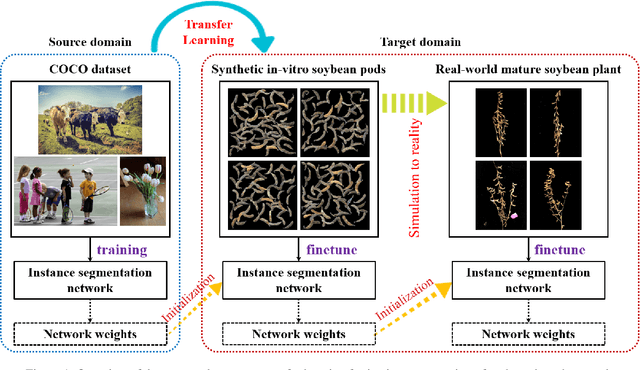

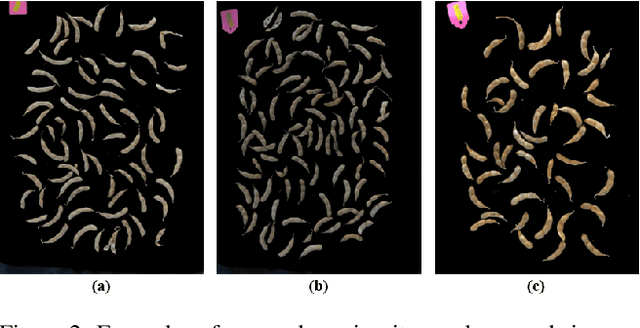

Abstract:The mature soybean plants are of complex architecture with pods frequently touching each other, posing a challenge for in-situ segmentation of on-branch soybean pods. Deep learning-based methods can achieve accurate training and strong generalization capabilities, but it demands massive labeled data, which is often a limitation, especially for agricultural applications. As lacking the labeled data to train an in-situ segmentation model for on-branch soybean pods, we propose a transfer learning from synthetic in-vitro soybean pods. First, we present a novel automated image generation method to rapidly generate a synthetic in-vitro soybean pods dataset with plenty of annotated samples. The in-vitro soybean pods samples are overlapped to simulate the frequently physically touching of on-branch soybean pods. Then, we design a two-step transfer learning. In the first step, we finetune an instance segmentation network pretrained by a source domain (MS COCO dataset) with a synthetic target domain (in-vitro soybean pods dataset). In the second step, transferring from simulation to reality is performed by finetuning on a few real-world mature soybean plant samples. The experimental results show the effectiveness of the proposed two-step transfer learning method, such that AP$_{50}$ was 0.80 for the real-world mature soybean plant test dataset, which is higher than that of direct adaptation and its AP$_{50}$ was 0.77. Furthermore, the visualizations of in-situ segmentation results of on-branch soybean pods show that our method performs better than other methods, especially when soybean pods overlap densely.
Behind the leaves -- Estimation of occluded grapevine berries with conditional generative adversarial networks
May 21, 2021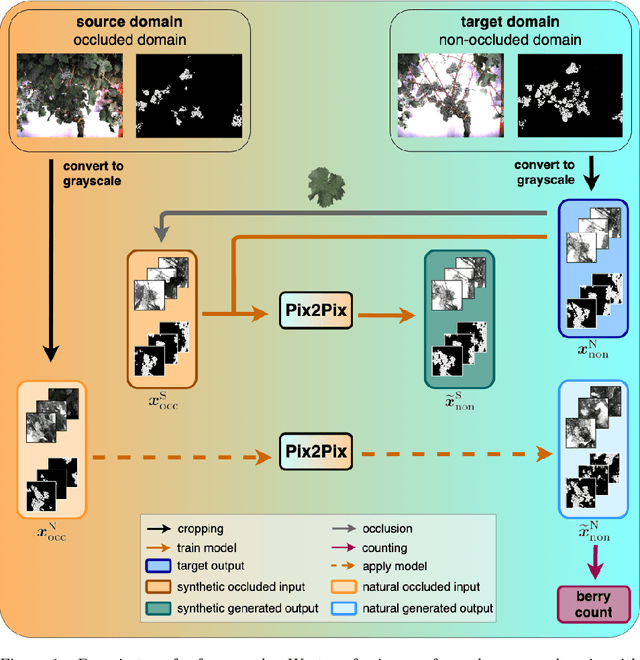
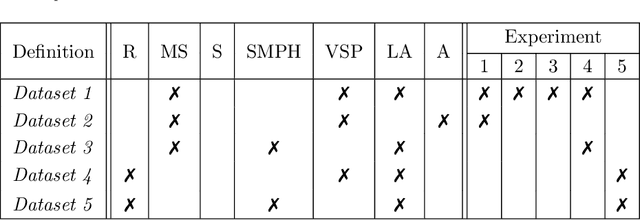

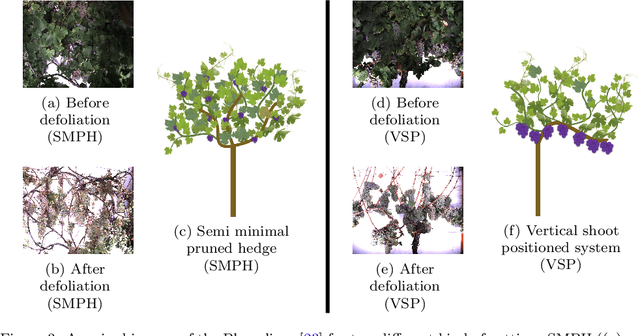
Abstract:The need for accurate yield estimates for viticulture is becoming more important due to increasing competition in the wine market worldwide. One of the most promising methods to estimate the harvest is berry counting, as it can be approached non-destructively, and its process can be automated. In this article, we present a method that addresses the challenge of occluded berries with leaves to obtain a more accurate estimate of the number of berries that will enable a better estimate of the harvest. We use generative adversarial networks, a deep learning-based approach that generates a likely scenario behind the leaves exploiting learned patterns from images with non-occluded berries. Our experiments show that the estimate of the number of berries after applying our method is closer to the manually counted reference. In contrast to applying a factor to the berry count, our approach better adapts to local conditions by directly involving the appearance of the visible berries. Furthermore, we show that our approach can identify which areas in the image should be changed by adding new berries without explicitly requiring information about hidden areas.
Counting of Grapevine Berries in Images via Semantic Segmentation using Convolutional Neural Networks
Apr 29, 2020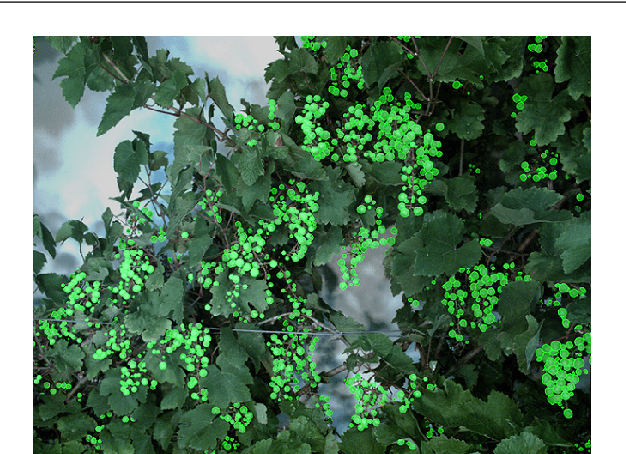

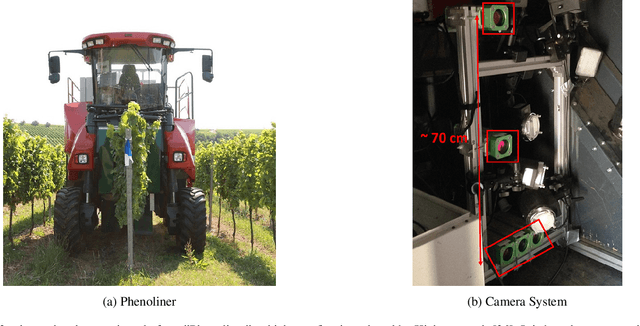

Abstract:The extraction of phenotypic traits is often very time and labour intensive. Especially the investigation in viticulture is restricted to an on-site analysis due to the perennial nature of grapevine. Traditionally skilled experts examine small samples and extrapolate the results to a whole plot. Thereby different grapevine varieties and training systems, e.g. vertical shoot positioning (VSP) and semi minimal pruned hedges (SMPH) pose different challenges. In this paper we present an objective framework based on automatic image analysis which works on two different training systems. The images are collected semi automatic by a camera system which is installed in a modified grape harvester. The system produces overlapping images from the sides of the plants. Our framework uses a convolutional neural network to detect single berries in images by performing a semantic segmentation. Each berry is then counted with a connected component algorithm. We compare our results with the Mask-RCNN, a state-of-the-art network for instance segmentation and with a regression approach for counting. The experiments presented in this paper show that we are able to detect green berries in images despite of different training systems. We achieve an accuracy for the berry detection of 94.0% in the VSP and 85.6% in the SMPH.
Detection of Single Grapevine Berries in Images Using Fully Convolutional Neural Networks
May 01, 2019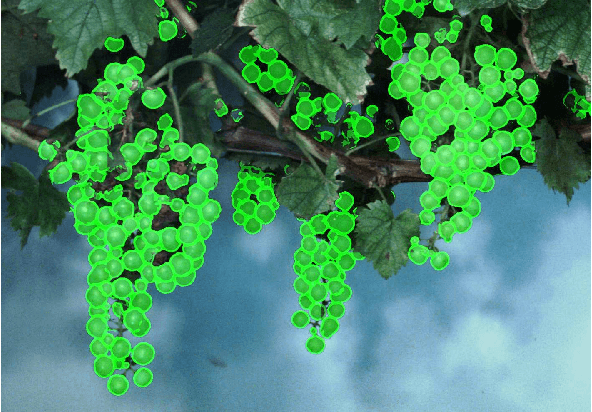

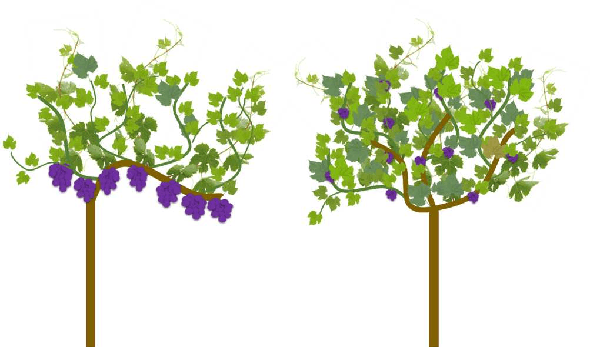

Abstract:Yield estimation and forecasting are of special interest in the field of grapevine breeding and viticulture. The number of harvested berries per plant is strongly correlated with the resulting quality. Therefore, early yield forecasting can enable a focused thinning of berries to ensure a high quality end product. Traditionally yield estimation is done by extrapolating from a small sample size and by utilizing historic data. Moreover, it needs to be carried out by skilled experts with much experience in this field. Berry detection in images offers a cheap, fast and non-invasive alternative to the otherwise time-consuming and subjective on-site analysis by experts. We apply fully convolutional neural networks on images acquired with the Phenoliner, a field phenotyping platform. We count single berries in images to avoid the error-prone detection of grapevine clusters. Clusters are often overlapping and can vary a lot in the size which makes the reliable detection of them difficult. We address especially the detection of white grapes directly in the vineyard. The detection of single berries is formulated as a classification task with three classes, namely 'berry', 'edge' and 'background'. A connected component algorithm is applied to determine the number of berries in one image. We compare the automatically counted number of berries with the manually detected berries in 60 images showing Riesling plants in vertical shoot positioned trellis (VSP) and semi minimal pruned hedges (SMPH). We are able to detect berries correctly within the VSP system with an accuracy of 94.0 \% and for the SMPH system with 85.6 \%.
 Add to Chrome
Add to Chrome Add to Firefox
Add to Firefox Add to Edge
Add to Edge